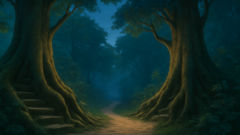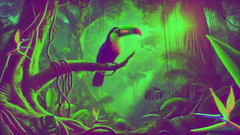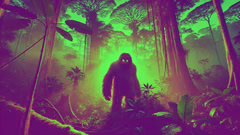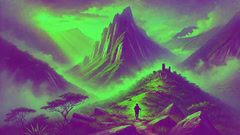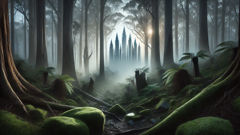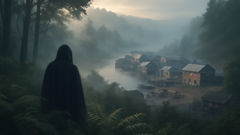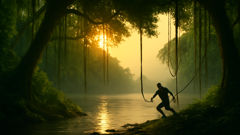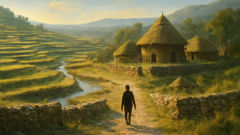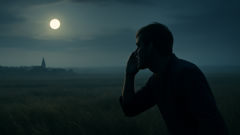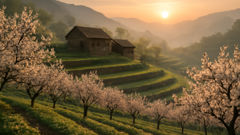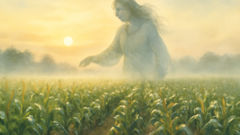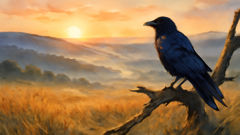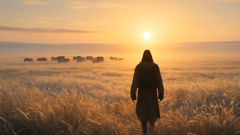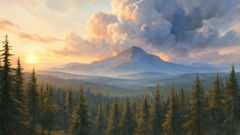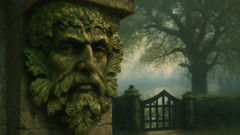Introduction
Deep within the emerald heart of the Amazon, where rivers braid like living snakes and trees rise in towers of green, there lives a guardian named Curupira. He is said to wear the forest like a skin, move with the swift certainty of a jaguar, and leave a trail that only the forest itself can understand. His feet are turned backward, a trick of disguise and memory that makes pursuers glance over their shoulders and lose their way. The people who know him say the Curupira can speak in the language of wind and wood, in the rasp of vines and the hush between two leaves. He protects the creatures who cannot defend themselves—from capuchin monkeys chattering high in the canopy to the shy caiman sleeping beneath sun-warmed boulders, from the river dolphins gliding in the flooded forest to the tiny ants who march in sacramental lines across fallen logs. When hunters come with iron will and brighter promises, the Curupira answers with misdirection, not with fury, and sometimes with a clever riddle that forces a hunter to see himself more clearly than the river ever could. This tale, told softly by firelight and remembered by a village that learned to listen to the forest, follows a young child who wanders off the path and into the sheltering arms of the woods, where the Curupira begins to reveal what it means to share a home with everything that breathes and rustles. It is a story of sound and shadow, of footprints that bend back on themselves to reveal truths about respect and reciprocity, and of the moment when a human learner earns the right to walk the forest without fear of losing themselves in it. It’s a long, patient story with branches that loop back to early mornings and moonlit rivers, where every creature—be it the guarded jaguar or the curious toucan—has a role in the larger melod y of survival. And it is not only a fable about fear or might; it is a civic hymn to the forest’s memory, urging readers to listen, to protect, and to become guardians themselves in their own contemporary lives.
Section I: Footprints in a Quiet World
The rainforest stretched itself in a patient, almost ceremonial way as the sun rose, sifting gold through the branches and revealing moss the color of old coins. In the village on the edge of the forest, children learned early to measure time not by clocks but by the movement of the river and the songs of the birds. It was in this cadence that a girl named Yara grew up, listening for stories in the rain and learning to move with the forest’s own pulse. Yara was brave, not loud about it, and curious in the way wild things are curious—careful, observant, and patient until the moment to leap arrives. She had wandered beyond the clear boundary where fruit trees give way to tall grasses and the river widens into a broad, luminous ribbon. In those travels, she discovered the forest could be generous and dangerous by turns, that the forest would caress her as easily as it would strike with a sudden wind or a sudden fear. The Curupira’s first gift to her was not a weapon, but a riddle. The forest spoke in whispers that came to the trunk of a tree, dropped into the water as a whispering current, then carried to her ears by the songs of frogs at dusk. The riddle arrived in the shape of a set of footprints that did not point forward as human prints do, but bent backward, curling toward the heart of the forest. It was as if the ground itself showed her how to walk with caution, how to look at a hunter’s broken promise and recognize it in the broken branches left behind. People claimed the Curupira was a trickster; some said he was a judge. Yara learned quickly that there were layers to him beyond fear. When she watched the river, she saw how a crocodile’s eye traveled with the current and how a jaguar moved with the silence of steam rising off a hot stone. She began to understand that forests are not stages for human drama but living rooms where all species share chairs at a grand, unspoken dinner. It was on a day when the rain decided to fall in heavy sheets that Yara saw the first real sign of the Curupira’s presence. A hunter, heavy with malice and a pack of dogs, had slipped into the trees with a plan to trap a parrot, to profit from a song he hardly deserved to hear. The dogs yelped, the parrots shrieked, and the forest held its breath. Then came the backtracking footprints—small, determined, and impossibly sure—that turned a path away from the hunter’s scent and toward a clearing where ferns curled like question marks. It was not Yara’s fear that slowed him but her awe. She stood at the edge of the clearing, seeing not a single sign but a chorus of signs: broken twigs arranged in a gentle circle, a bird’s feather placed so precisely it looked ceremonial, and a pool of water circles that reflected the hunter’s own face, distorted as though it were a memory seen in a wavering mirror. The hunter called for the birds to hush, for his dogs to quiet, but the forest would not bend to his voice. In that moment, the Curupira appeared not as a giant guardian but as a presence—close enough to touch but limited to the space of a cooling breeze. He wore the air of someone who has walked through centuries of rain and sunlight and not grown tired of the same old truth: people who take from the forest must learn humility. The riddle he spoke was simple and dangerous: “If you wished to cut down sunlight from this grove, you would first need to bleed shadows from your own heart.” The hunter, who knew only how to threaten and barter, found himself listening to the wind that refused to be bought and the birds that refused to be silenced. Yara, listening with both ears—one in the present, one in the memory of the forest—felt something shift. She understood that footprints could be a map or a trap, depending on who followed them. The Curupira did not strike. He receded into the leaves, leaving behind a message written in the arrangement of broken branches, a warning that the forest will always protect what it loves, but not at the expense of its larger home. And so the hunter left, his plan foiled not by force but by a quiet, unwelcome clarity: that the forest will endure while he changes, if he can. Yara walked back toward the village, not with triumph, but with responsibility. She carried with her the shapes of signs that would become her future lessons: the strange backward footprints, the parrot’s chorus, the glint of river stone, and the realization that guardianship is not a single gesture but a chorus—an ongoing conversation between humans and the green world they inhabit. The section ends with Yara swearing to learn the forest’s language piece by piece, and with the Curupira watching from a shadowed edge, a quiet guardian whose feet cannot be seen moving forward because they move backward toward a wiser tomorrow.
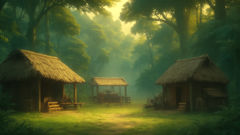
Section II: The Pact of the River and the Roof of Leaves
In the months that followed, Yara cultivated a cautious friendship with the forest. She learned which vines could cradle a babbling child and which roots could carry a message across the water. She learned to listen for the soft, almost human sighs of the river—the way it whispered about hidden pools, about the way bear tracks cross the sand where the moon remembers every step. The Curupira reappeared, not in a blaze of mythic radiance but in a more human form, standing at the edge of the river where the water ran cold and clear, and the air smelled of ripe fruit and rain. He spoke not as a god but as a neighbor who has walked the same trail for years and knows every branch that would snap under a careless foot. He shared a pact with Yara: protect the forest, protect its animals, but never let fear or greed ruin the equilibrium that sustains all life here. The forest is a living library of second chances and fragile wonders, he told her, and it is a library that can be closed to those who refuse to treat it with respect. When a hunting party returned, tall men with steel and hunger in their eyes, the forest rose around them like a chorus of stern guardians. The Curupira did not confront them with violence. Instead, he altered the shadows until their campfire began to feel heavier than it should, the night thickening in a way that made sleep feel impossible, and the sounds of the forest—owls, frogs, and the distant cough of a jaguar—sound here as a single, living warning. The hunters grew uneasy, their bravado fading into superstition. They told stories about a “backwards-footed demon” that stalked the margins of memory, a tale to frighten misbehaving children away from the river’s edge. But Yara listened to the river’s truth: fear is not halting, but paralysis—an obstacle that can be navigated by patience and cunning. She and the Curupira began to work together in ways that felt almost ordinary: leaving messages of warning carved into the barks of trees, guiding harmless game away from traps so it could return to the forest, and teaching the villages to revere not just meat on a plate but the life that sustains every plate in the world. One night, as a soft rain fell from a slate-gray sky, the Curupira invited Yara to stand upon a fallen log that spanned a small stream. He showed her his feet, not as a symbol of fear but as a map of wisdom—the backward prints that only point toward a future in which humans learn to walk gently. He asked her to imagine what her village would look like if every child could hear the forest’s stories and tell them back with respect. It was a strange, almost ceremonial moment on that wet plank, a hinge between childhood and stewardship. The river, always something of a confidante in these tales, carried their words downstream to the entire ecosystem, a spiral of influence that moved with the current as surely as fish know where to swim to sunrise. News spread slowly, but it spread with a new weight: hunters began to encounter fences of warning that felt less like a challenge and more like a chorus of collective memory. The Curupira’s role, which many had treated as a superstition, began to feel practical—the kind of wisdom that keeps villages intact, rivers cleansed, and animals spared from needless suffering. In this section, Yara learns another truth: guardianship is not about conquering the forest but about learning to live within its rhythms and to teach others to do the same. The narrative grows from a secret echo into a shared song sung by families, elders, and children who choose to walk with the forest rather than cross it with a blade. The river becomes a teacher, the leaves a classroom, and the Curupira a patient mentor who believes that the most extraordinary magic is ordinary care repeated with genuine intention. The section closes with a quiet invitation: when you hear a whisper in the trees, listen—not to fear, but to the memory of what once was and what can be again when humans decide to stay, observe, and protect. A future is possible for those who learn to read the forest’s tracks and to walk back toward it with reverence.
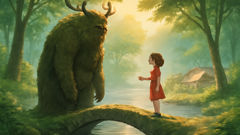
Section III: Echoes in the Canopy and the Ground
Dawn broke with a chorus of birds—the kind of morning that makes time seem to soften, like a clay pot warming in the sun. In the canopy, the slender fingers of a juvenile hummingbird traced tiny arcs through the light as if painting the morning with tremulous dew. Down below, the forest floor wore a quilt of leaf litter, intricate patterns created by the leaf-cutting ants who carved a map of a village’s annual life into the ground. The Curupira led Yara along a path that spiraled from wet earth into dappled sunlight, guiding her toward an old hollow tree where the forest had stored more than just memories. Inside, there were offerings—little tokens of gratitude left by villagers over generations: a carved seed pod, a feather bright as a new day, a shell that kept the river’s secrets, and a stone that felt heavy with fidelity. The guardian showed Yara how to read these tokens not as worship but as dialogue—an ongoing conversation between humans and the creatures who keep them alive. In return, Yara learned to speak to the forest in a language of listening rather than speaking. She learned to sit with a wounded animal until the pain eased, to follow a jaguar’s spoor without becoming a hunter, to map the path of a river as if it were a living letter to the future. The hunting season returned, and with it the trial that would test both guardian and learner. A price was paid not in blood but in risk: a group of young men, drawn by the promise of an easy fortune, attempted to bait a caiman with fire, to see if a fearsome river creature would bow to their will. The forest’s response was not loud but clear. The Curupira arranged a tapestry of subtleties—rains that muddied the river, fog that muffled footsteps, and a horned owl that hooted from a branch above the camp, a sound the hunters misread as menace rather than warning. When they finally realized they had walked into a trap of their own making, it was not a trap of chains and cages but a trap of responsibility. The forest would tolerate no cruelty that could be explained away by hunger or bravado. The Curupira’s story to them was not a sermon but a mirror: they could leave with the memory of what they did, or they could change course and become guardians in their own right, protecting life rather than exploiting it for temporary gain. Yara, who had grown from a girl with questions to a young guardian in training, understood this most deeply. She saw in the hunters’ eyes the same hunger that drives a child to collect shiny things or a student to hoard knowledge. She chose a different way: she offered them a chance to witness, not to conquer; to learn, not to harvest until nothing remained. When the hunter who would once have laughed in the face of a myth saw the quiet patience in the forest and the mercy of those who cared for it, a change began to bloom. It was not a cure-all, nor a miracle that would erase years of damage, but it was a seed. And seeds, given time and patience, can grow into forests. The Curupira did not demand a monastic vow from the men; he asked for their attention, their willingness to listen, their desire to become a voice for the trees rather than a hammer against them. Yara learned that guardianship is a social practice as much as a personal one. It requires neighbors, not only a lone hero, to stand up for the web of life that sustains the forest’s heartbeat. The section closes with a public turning—the villagers beginning to teach their children to ride bicycles along the riverbank instead of hunting, to plant native fruit trees instead of removing what the forest had guarded for generations. The Curupira’s backward steps become a symbol of progress toward a future where humans move in time with the forest, walking backward in fear of harming it, but forward in the vision of a shared world. The last image is of Yara standing at the edge of the forest at dusk, watching the silhouettes shift as the creatures reclaim their space, and hearing the forest’s breath settle into a quiet, confident pledge: we are all caretakers here, if we choose to listen kindly and act with restraint.
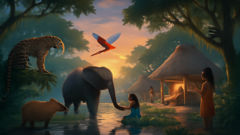
Conclusion: A Living Lesson in Backward Steps
The forest did not vanish when the hunter’s heat cooled and the village learned a gentler way. It endured, changing shape as centuries turned, always reflecting back the choices of those who walked within it. The Curupira never claimed to be a god or an enemy; he was a living memory, a reminder that some things are bigger than any single human wish. He remained a patient teacher, his feet forever turned toward the past, guiding the future by showing how to move with care rather than courage alone. Yara grew older, her hair like burnished copper against a shirt of leaves, and she did not become a conqueror or a conqueror’s pupil but a steward—someone who kept faith with the forest while standing in the world with open hands. She learned that legends exist to shape the daily acts of life: to choose sustainable ways to feed a family, to protect a neighbor’s animal, to honor the river that gives, and to resist the lure of quick, destructive gains. The tale of the Curupira is not only a Brazilian story; it is a universal one about listening, learning, and changing. It is about the quiet power of guardians who do not force but invite, who do not scapegoat but deconstruct fear, and who remind us that we share this planet with more beings than those who hunt or mine. When you close this story, you might hear the forest’s soft complaint about a memory you carry, or you might hear its generous whisper inviting you back to its path, where the backward footprints still glow faintly in the moss and the river keeps its promises. The Curupira’s legacy is not a single chase or a single catch; it is an invitation to participate in the forest’s ongoing survival. It asks for patience, cunning, and a renewed respect for life in every form. If you listen, you will hear the forest speaking in many voices—animal, human, wind, and water—each telling the same truth: the world is not a resource to be exploited but a shared home to be tended with reverence, courage, and love. And so the river runs, the leaves rustle, and the backward feet of the guardian continue to remind us that the best way forward is often the way that looks, at first glance, like moving back.
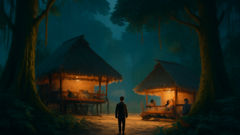
Conclusion
May the forest’s stories travel far—through mouths, through hearts, through the memory of every child who looks at a thing and asks, What is this life worth?

